Skoda’s RS models have been providing surprising delight for 50 years now.
Few, if any, of the motor racing fraternity saw the oh-so-cute rear-engined 110, 130 and 200 RS models coming back in the mid-1970s, but with class wins in the European Touring Car Championship and the 1977 Monte Carlo rally, the little Iron Curtain racers more than proved their worth.
Zip forward two decades, and the 1998 launch of the original Octavia RS proved that Skoda (at the time) could make a better GTI than parent company Volkswagen – and it came with a bigger boot…
Today, the RS lineup is firmly ingrained in the Skoda range, with sporty versions of the Octavia, the Kodiaq and the all-electric Enyaq on sale.
This new 2026 Skoda Elroq RS is, like the standard Elroq, closely related to the Enyaq and uses the same MEB electric car underpinnings. Giving the RS treatment to the Enyaq resulted in a fast, but not truly exciting SUV, so can the more compact Elroq make a better fist of earning its RS badge?
How much does the Skoda Elroq cost?
Australian prices for the Elroq RS haven’t been set yet, but going by European pricing it’s likely to command at least a $10,000 or so premium over the standard 85 Select variant, suggesting a price in the region of $70,000.
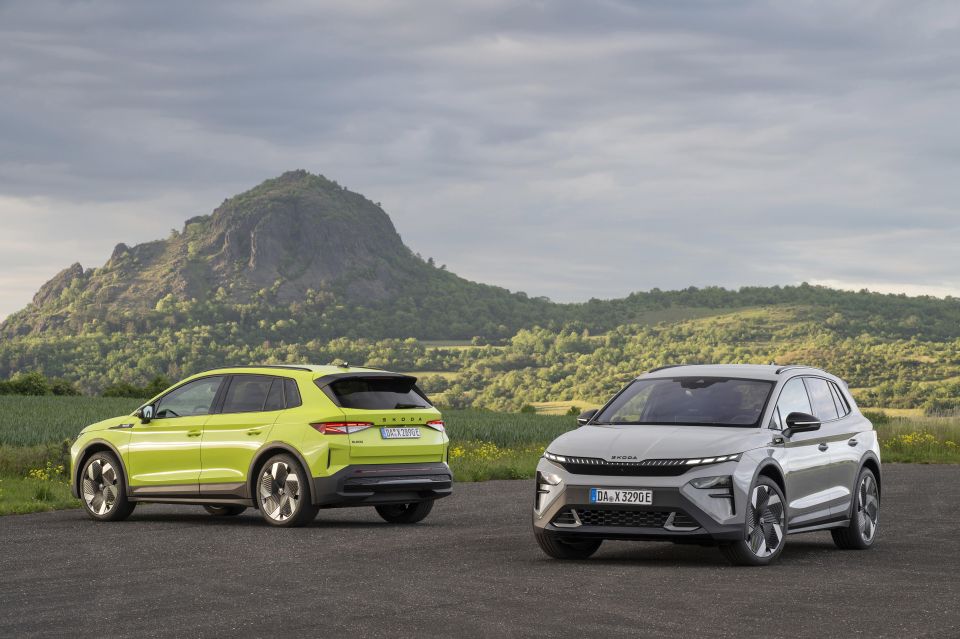
If that’s the case, it will be considerably more expensive than the dual-motor BYD Sealion 7 Performance , which is much more powerful and faster in a straight line, but as you’ll read further down, the Elroq RS is considerably better to drive than the rather vague BYD.
To see how the Skoda Elroq lines up against the competition, check out our comparison tool
What is the Skoda Elroq like on the inside?
We reckon that the standard Elroq has one of the best interiors in the business, and it’s certainly nicer, roomier and has better tactile qualities than its closest rival, the Kia EV3.
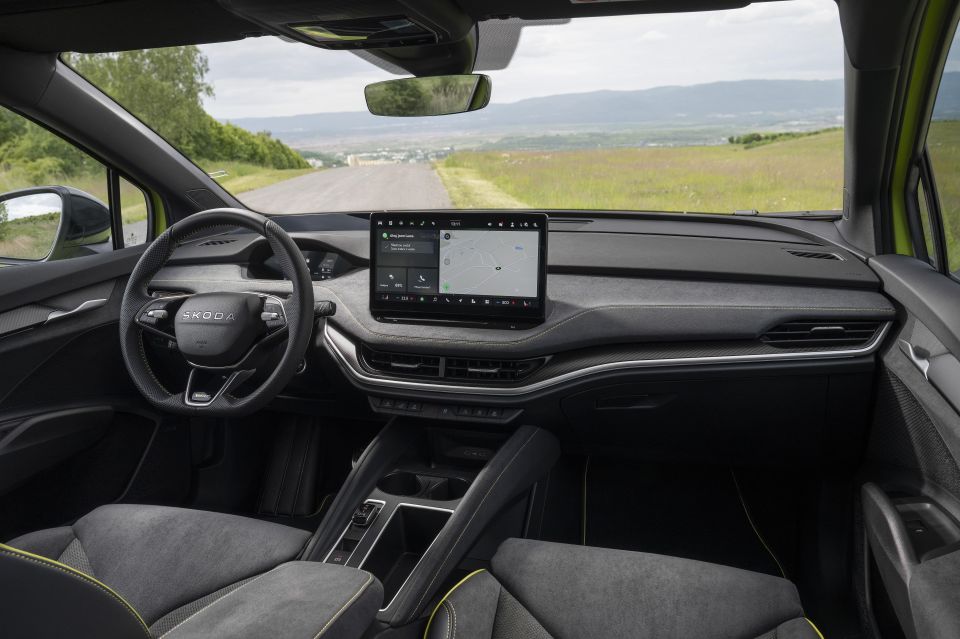
The Elroq RS takes that as a starting point and then hares into the distance thanks to lots of soft-touch synthetic suede (made from recycled plastics, and nicer to the fingertips than the usual microfibre Volkswagen Group trim).
That ‘suede’ stretches, with contrast lime green stitching, from the dash to the doors to the excellent high-backed bucket seats.
Those seats look like they’re going to squeeze you too tight, but actually they’re as soft and yielding as the best that Eames can provide.
Space both front and rear is excellent, with lots of legroom in the back even if there are tall people in the front. There’s also plenty of storage space in the box under the armrest and the large open space under the centre console, although you’ll also find a few cheap plastics looking to spoil the show in those areas.
The big 13-inch touchscreen is getting easier to use with each software re-flash, and the bank of proper physical switches beneath help with getting to the function you need more quickly, but we’d prefer if the screen was a touch smaller, as it tends to dominate the dash and snatches at your attention too much.
The three-spoke RS spec steering wheel is good though and feels great to hold with its perforated leather rim and more lime-green stitching.
Boot space isn’t brilliant – 470 litres – but there are the usual clever Skoda touches, including an optional net, which dangles from under the parcel shelf to tidy the charging cable away (which makes up, a bit, for the lack of a ‘frunk’ in the nose).
| Dimensions | Skoda Elroq |
|---|---|
| Length | 4488mm |
| Width | 1884mm |
| Height | 1625mm |
| Wheelbase | 2765mm |
| Cargo capacity | 470-1580 litres |
To see how the Skoda Elroq lines up against the competition, check out our comparison tool
What’s under the bonnet?
Skoda has added an extra electric motor to the Elroq to turn it into an RS, giving it all-wheel drive and a maximum power output of 250kW.
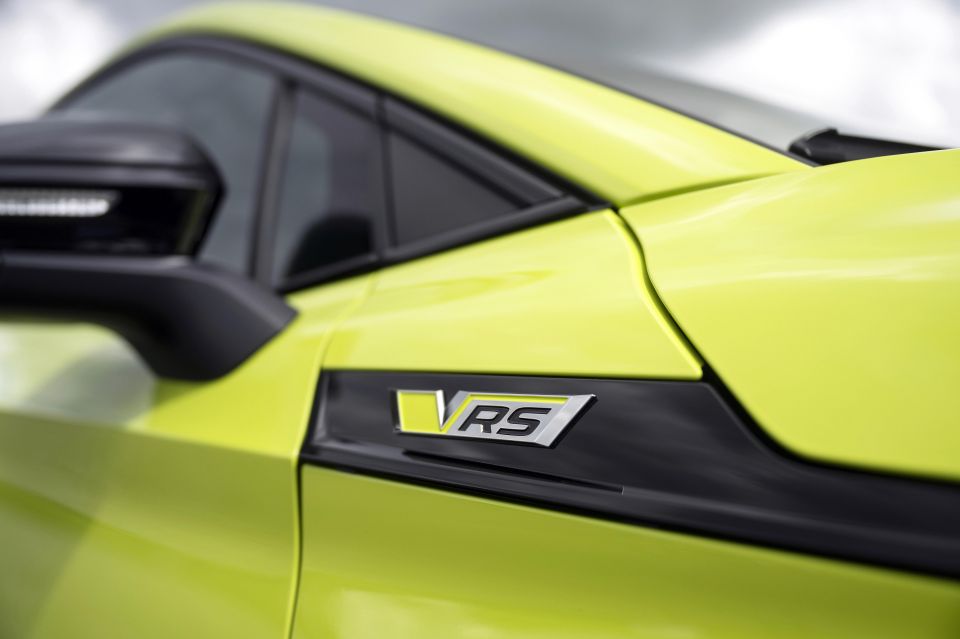
| Specifications | Skoda Elroq RS |
|---|---|
| Drivetrain | Dual-motor electric |
| Battery | 79kWh li-ion |
| Power | 250kW |
| Torque | 134Nm + 545Nm |
| Drive type | All-wheel drive |
| 0-100km/h (claimed) | 5.4 seconds |
| Energy consumption (claimed) | 16.4–17.2 kWh/100 km |
| Energy consumption (as tested) | 20.0kWh/100km |
| Claimed range | 549km – WLTP |
| Max AC charge rate | 11kW |
| Max DC charge rate | 185kW |
The rear motor does more of the donkey work though, with its 545Nm torque dwarfing the 134Nm of the front motor. Even so, the extra traction advantage clearly helps, as the Elroq RS rockets off the line in the manner you’d expect from a sporty electric car and will hit 100km/h in a brisk 5.4 seconds.
Performance is good when you’re rolling too, with a solid slug of ‘tip-in’ torque for overtaking or for picking up speed on a multi-lane highway.
It’s not outrageously fast, in the manner of a BYD Sealion 7, but it’s fast enough to feel impressive. There’s multi-level regenerative braking too, controlled by the paddles behind the steering wheel, although there’s not strictly speaking a ‘one-pedal’ mode.
That said, you can use the ‘auto’ setting for the regenerative braking, which will slow you down more smoothly in traffic. The brake pedal itself could do with a bit more firmness at the top of its travel, but the physical brakes work well when you need to do some serious stopping.
Overall, the Elroq RS proved to be pretty efficient on our test drive. We never matched Skoda’s official energy consumption, but a day of brisk driving using Sport mode most of the time saw a return of 20kWh/100km making for a realistic driving range is around 460-480km.
The battery also charges up quickly – at up to 185kW on a high-powered DC fast-charger.
To see how the Skoda Elroq lines up against the competition, check out our comparison tool
How does the Skoda Elroq drive?
The Elroq RS is planted, feels sophisticated and very assured on fast, flowing roads.
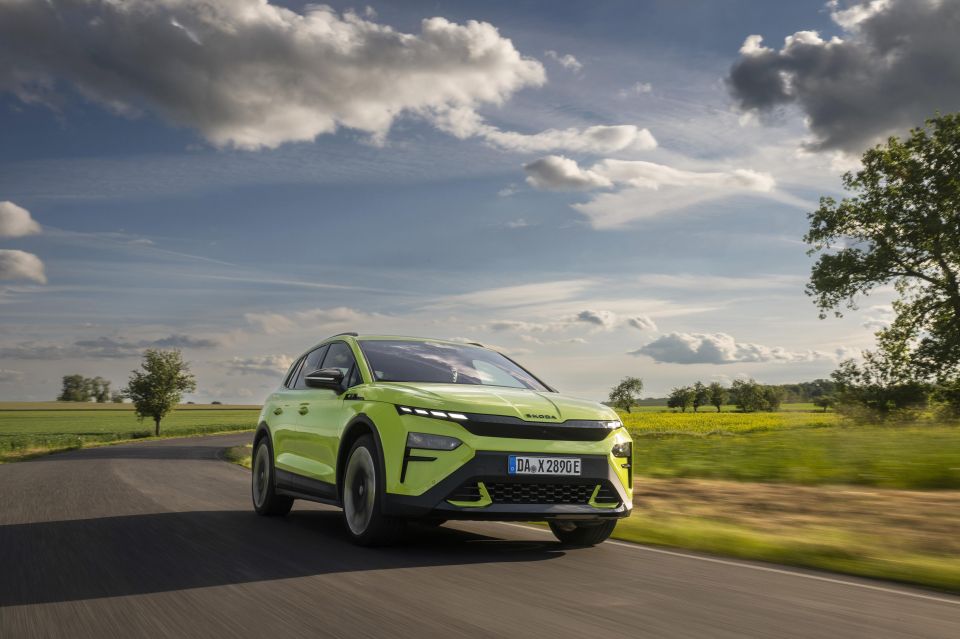
That’s all good, and exactly what you’d expect of a Skoda RS product.
However, it does lack a bit of bite, that last nth of driver involvement and thrill, and hence seems to be part of a recent trend with Skoda’s RS models, in that they seem to be getting a little softer, and a little more tuned towards all-round performance than to outright driver engagement.
Perhaps Skoda is playing to its target market of customers who want a car that’s fast and well-controlled, but still easy-going enough to be a daily driver. Equally, it doesn’t mean that the Elroq RS is a floppy mess on a fast road.
Far from it. The steering has a beefy sense of weight to it, and just a faint tickle of communication from the front tyres feeding back to your hands.

The adaptive dampers allow you to choose between really soft, firm, or really hard settings (with a few shades of difference between those points if you configure the ‘Individual’ driving mode setup) but really Sport mode is the best default setting.
It means that the dampers are firm enough to keep the tall body under control, but not so hard that you feel rattled about on a rippled surface.
The Elroq RS is actually really enjoyable on a road with plenty of fast, well-sighted corners which were in abundance on our test route through the Czech countryside near Prague.
It becomes a little less enjoyable when the corners get tighter, as the 2.2-tonne weight makes itself known when you’re slowing down for a tighter apex, but you’d never call it unruly.
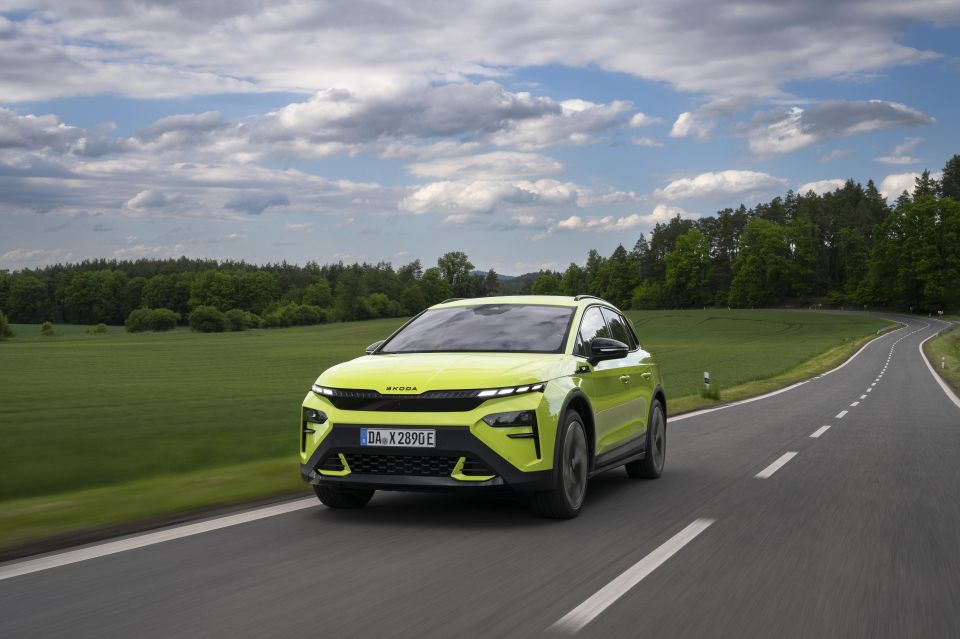
The ride comfort is generally very good, although on a really bumpy surface, you can feel the suspension struggle a little to keep the combined movements of the big wheels and the hefty body under proper control.
Overall refinement is fine, but there’s a surprising amount of wind noise noticeable at highway speeds.
So, the Elroq RS is, perhaps, not quite as keen-edged as you’d expect a car wearing a hallowed motorsport badge to be, which is perhaps a shame (and the same issue lightly afflicts the updated Octavia RS too, certainly compared to its predecessor).
However, as a car that strikes a good balance between back-roads fun and everyday comfort and refinement, it’s hard to overly criticise the Elroq RS.
To see how the Skoda Elroq lines up against the competition, check out our comparison tool
What do you get?
Australian specifications aren’t known as yet, but we can use the core range as a guide.
2025 Skoda Elroq 85 Select equipment highlights:
- 19-inch Regulus alloy wheels
- Keyless entry, start
- 13-inch touchscreen infotainment
- Wireless App-Connect
- Apple CarPlay – Wireless
- Android Auto – Wireless
- Wireless smartphone charger incl. ventilation
- Dual-zone climate control
- Heated front seats
- Leather-wrapped steering wheel – heated
- Heated, folding, auto-dimming side mirrors
- Mode 3 (Type 2) charging cable
- 1 x door-mounted umbrella
Elroq 130 Edition adds:
- 21-inch Supernova alloy wheels
- Matrix LED headlights
- Dynamic headlight range control
- Dynamic cornering lights
- Premium LED tail lights
- Head-up display incl. AR function
- Intelligent Park Assist
- Power-adjustable front seats
- incl. electric lumbar
- incl. massage function
- incl. memory function
- 360-degree parking cameras
- Canton 12-speaker audio
- Power tailgate
- ‘Premium’ interior finishes
- Rear sunshades
To see how the Skoda Elroq lines up against the competition, check out our comparison tool
Is the Skoda Elroq safe?
We’re not sure yet, as the Elroq hasn’t yet been tested by ANCAP or Euro NCAP.
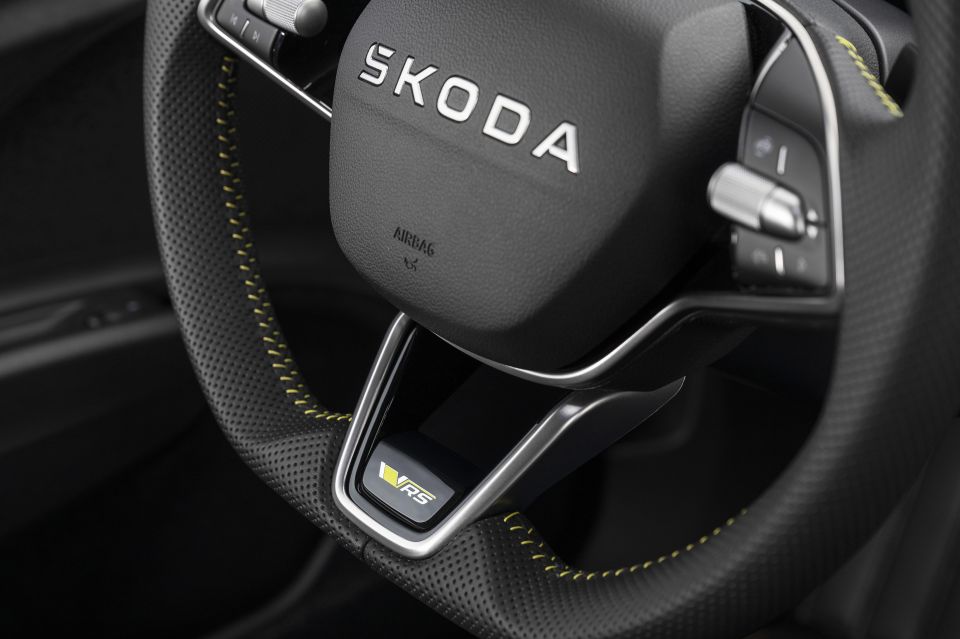
Sharing its structure with the five-star Enyaq should help, and this RS version comes with some extra standard safety equipment too, so it should be an exceptionally safe car.
Standard safety equipment on the Australian Elroq includes:
- 7 airbags
- Travel Assist
- Adaptive cruise control
- Traffic Jam Assist
- Adaptive Lane Assist
- Emergency Assist
- Front Assist – AEB
- Side Assist
- Blind-spot monitoring
- Exit Warning
- Rear cross-traffic alert
To see how the Skoda Elroq lines up against the competition, check out our comparison tool
How much does the Skoda Elroq cost to run?
As the range-topping model, the Elroq RS isn’t cheap and, even then, there are some pricey options packs to peruse.
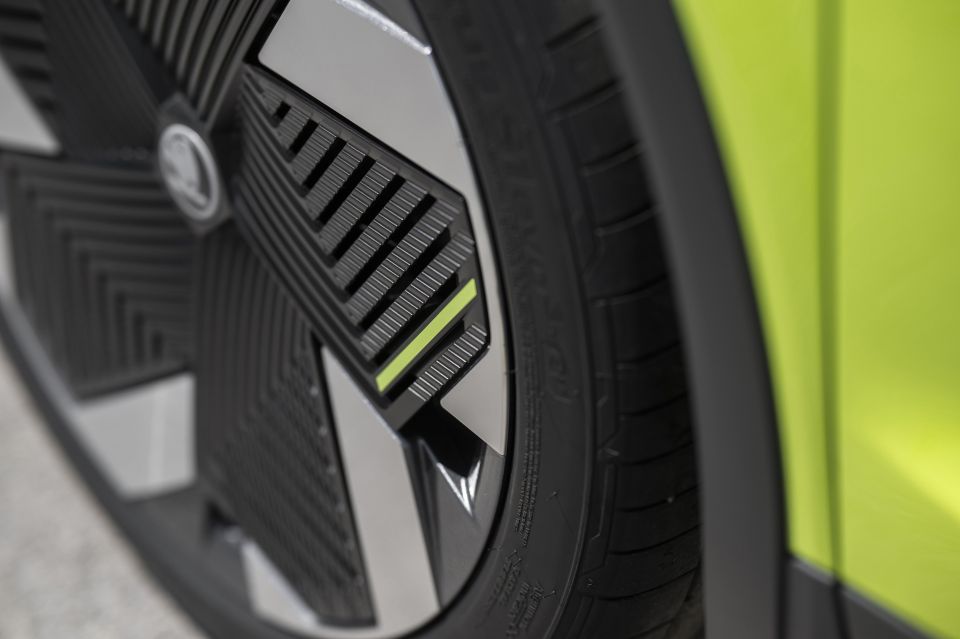
However, electric power means that you can run this high-performance, all-wheel drive, RS-badged card for relatively little compared to a petrol-powered equivalent.
Assuming you’re on a good 16c per kWh rate at home, you could fully charge the Elroq RS for as little as $12.60 and the resulting circa-460km real-world range is a lot more than you’ll get for $12.60 worth of unleaded.
It’s not the most efficient car around but equally it’s far from the ‘thirstiest’ electric car we’ve tested, and that’s impressive considering the robust performance on offer.
Equally, Skoda Australia offers a very good seven-year, unlimited kilometres warranty, and the battery is covered for eight years and up to 160,000km if there are any problems with a drop in stored energy capacity.
Electric cars generally require far less maintenance than a combustion-engined model, but keep an eye out for higher tyre wear.
To see how the Skoda Elroq lines up against the competition, check out our comparison tool
CarExpert’s Take on the Skoda Elroq RS
There is a faint sense of disappointment that the Elroq RS isn’t a little less Elroq and a little more RS.

If we’re being picky, then it could certainly do with being a touch sharper and more overtly engaging to drive (perhaps a more aggressive set of tyres would do the job, at the cost of a little range).
However, that criticism can be partly waved away as Road Tester Syndrome – taking a longer view, the Elroq RS is likely to prove a deeply satisfying car to own, combining as it does strong straight-line performance, good deportment and just enough driver appeal in the corners, useable range, excellent quality and the usual Skoda-style practicality.
As a family-friendly car with the promise of a mildly naughty thrill on the way home from the school drop, the Elroq RS is hard to beat.
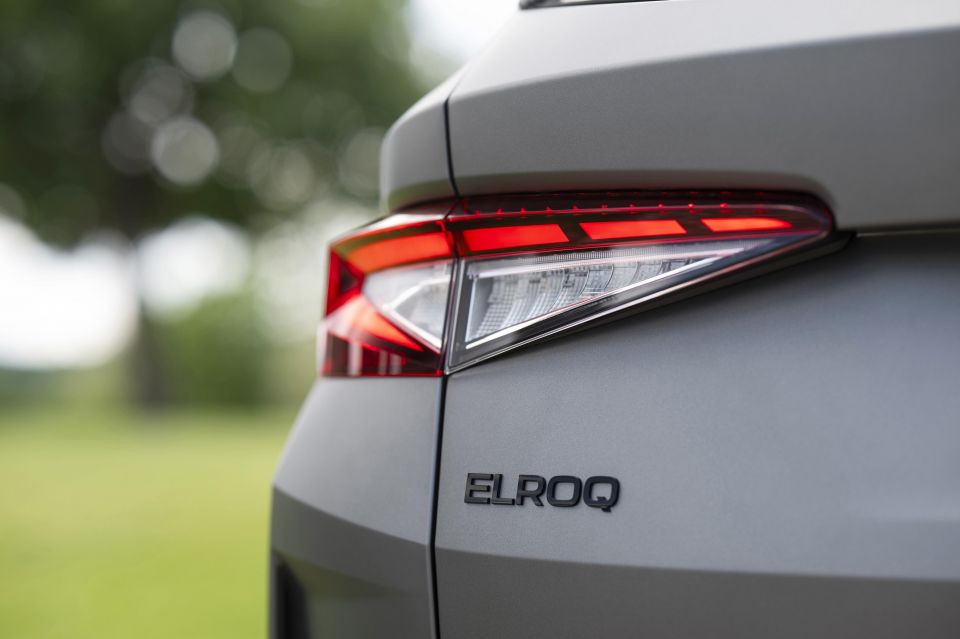
Interested in buying a Skoda Elroq? Let CarExpert find you the best deal here
Click the images for the full gallery
MORE: Explore the Skoda Elroq showroom


